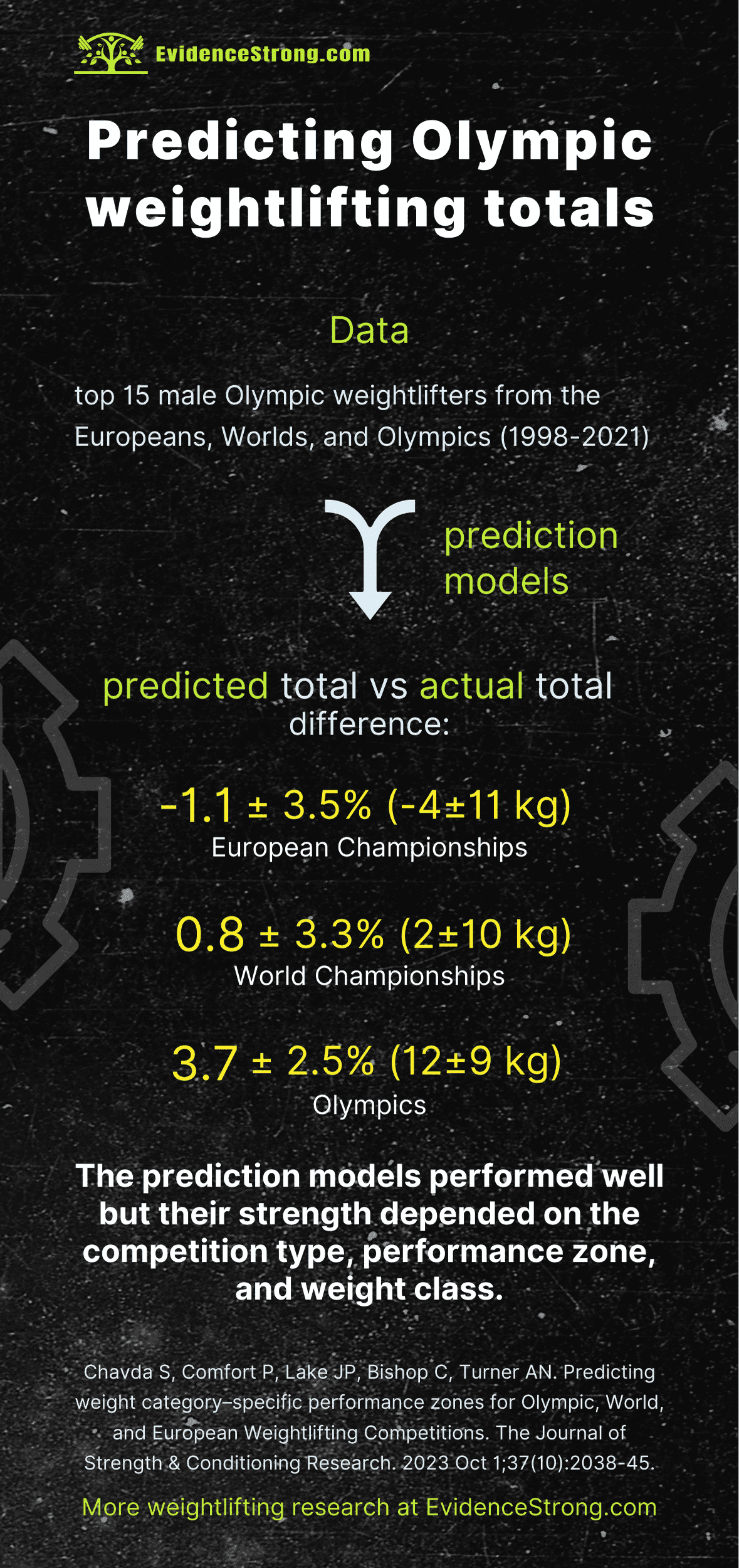Summary of a study investigating the totals required to medal in international competitions.
Who
Top 15 male athletes from the Europeans, Worlds, and Olympics from 1998 to 2021 (4,011 samples from old weight categories, 639 samples from the new weight categories)
Design
Data analysis of historical totals (snatch + clean&jerk) of 1-15 best athletes at the Europeans, Worlds, and Olympics from 1998 to 2021 (4,011 samples) + data from the performances in the new weight classes from the 2020+1 Tokyo Olympics (639 samples).
Outcome measures/tests
- competition totals
- competition zones:
- zone 1 - places 1st to 3rd (medal positions)
- zone 2 - 4th & 5th
- zone 3 - 6th to 8th
- zone 4 - 9th & 10th
- zone 5 - 11th to 15th
Main results

differences in totals were mostly trivial between years, so they were pooled together for each competition type (Europeans,
Worlds, Olympics)
the prediction models performed well but their strength depended on the competition type, performance zone, and weight category.
on average, the predicted total displayed a difference from the actual total of -1.1±3.5% (-4±11kg) for the European Championships, 0.8±3.3% (2±10kg) for the Worlds, and 3.7±2.5% (12±9kg) for the Olympics. Also, the error increased the lower down the performance zone (i.e. 11th -15th).
medal zone (place 1 -3) predicted and actual totals for the Europeans, Worlds, and Olympics:
Europeans
predicted total [kg]
actual total (±SD) [kg]
difference [kg]
Worlds
predicted total [kg]
actual total (±SD) [kg]
difference [kg]
Olympics
predicted total [kg]
actual total (±SD) [kg]
difference [kg]
actual total (±SD) [kg]
251 (±9)
actual total (±SD) [kg]
270 (±16)
actual total (±SD) [kg]
not contested
actual total (±SD) [kg]
287 (±5)
actual total (±SD) [kg]
310 (±6)
actual total (±SD) [kg]
303 (±10)
actual total (±SD) [kg]
314 (±5)
actual total (±SD) [kg]
330 (±6)
actual total (±SD) [kg]
328 (±6)
actual total (±SD) [kg]
339 (±4)
actual total (±SD) [kg]
351 (±8)
actual total (±SD) [kg]
351 (±12)
actual total (±SD) [kg]
358 (±9)
actual total (±SD) [kg]
373 (±5)
actual total (±SD) [kg]
369 (±5)
actual total (±SD) [kg]
369 (±6)
actual total (±SD) [kg]
372 (±2)
actual total (±SD) [kg]
Not contested
actual total (±SD) [kg]
380 (±15)
actual total (±SD) [kg]
403 (±10)
actual total (±SD) [kg]
392 (±9)
actual total (±SD) [kg]
381 (±7)
actual total (±SD) [kg]
395 (±2)
actual total (±SD) [kg]
Not contested
actual total (±SD) [kg]
439 (±34)
actual total (±SD) [kg]
422 (±11)
actual total (±SD) [kg]
421 (±10)
actual total (±SD) [kg]
455 (±20)
actual total (±SD) [kg]
457 (±20)
actual total (±SD) [kg]
451 (±33)
Take home message
For a clinician & coach
The prediction models performed well but their strength depended on the competition type, performance zone, and weight category. On average, the predicted total displayed a difference from the actual total of -1.1±3.5% (-4±11 kg) for the European Championships, 0.8±3.3% (2±10 kg) for the Worlds, and 3.7±2.5% (12±9 kg) for the Olympics. Also, the error increased the lower down the performance zone (i.e. 11th -15th).
For a parent
The prediction models performed well but their strength depended on the competition type, performance zone, and weight category. Predicted totals were the closest to the actual totals for the Worlds (the average difference was less than 1% or 2 kg). Also, the error increased the lower down the performance zone (i.e. 11th -15th).
For an athlete
The prediction models performed well but their strength depended on the competition type, performance zone, and weight category. Predicted totals were the closest to the actual totals for the Worlds (the average difference was only 0.8±3.3% or 2±10 kg). Also, the error increased the lower down the performance zone (i.e. 11th -15th).
Original article
Chavda S, Comfort P, Lake JP, Bishop C, Turner AN. Predicting weight category–specific performance zones for Olympic, World, and European Weightlifting Competitions. The Journal of Strength & Conditioning Research. 2023 Oct 1;37(10):2038-45.
You might want to read next
Tokyo 2020 weightlifting medalists’ characteristics
What was different in the development of elite vs sub-elite Olympic weightlifters?
Stable and variable components of the lifts in Olympic weightlifting
